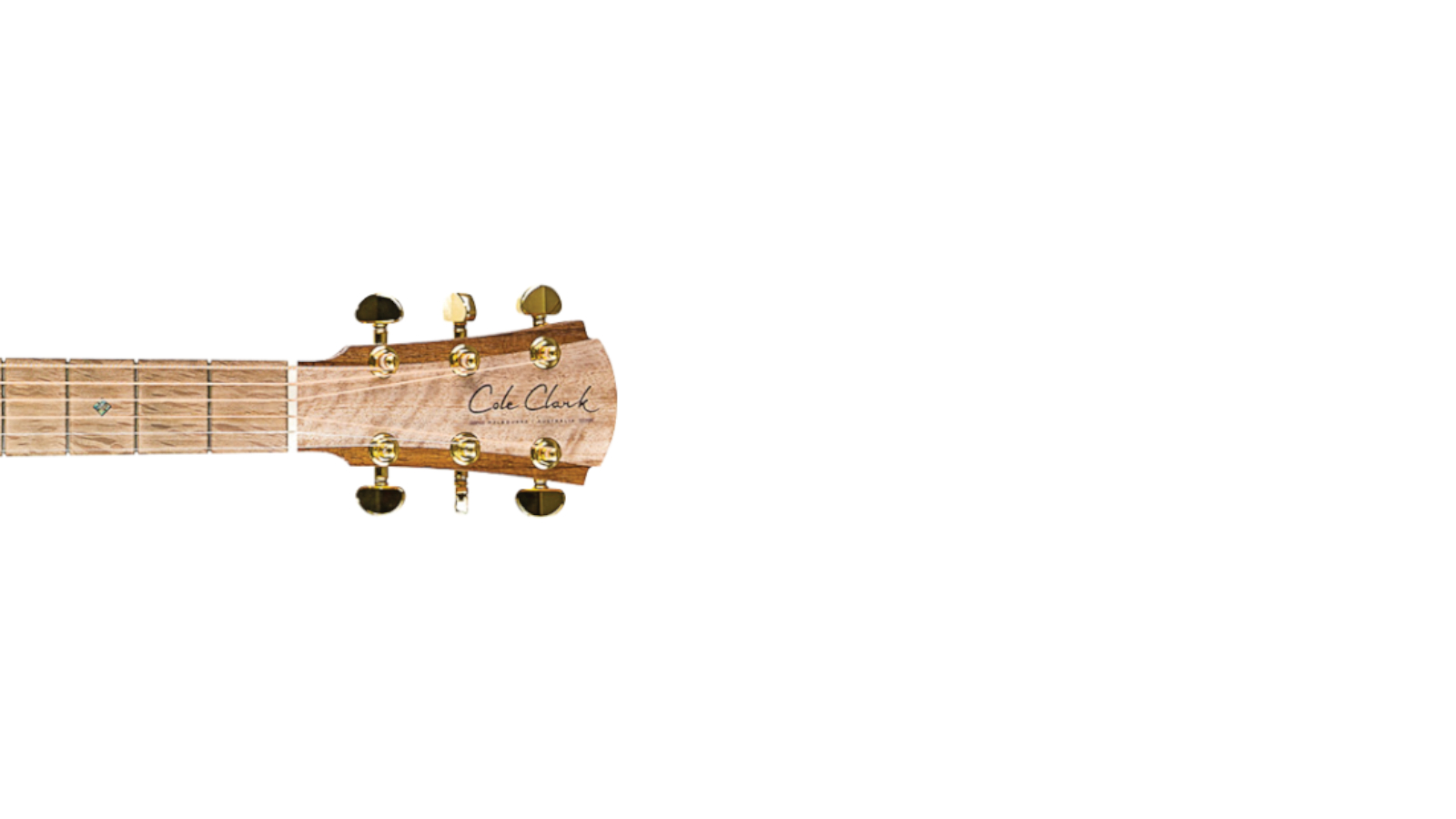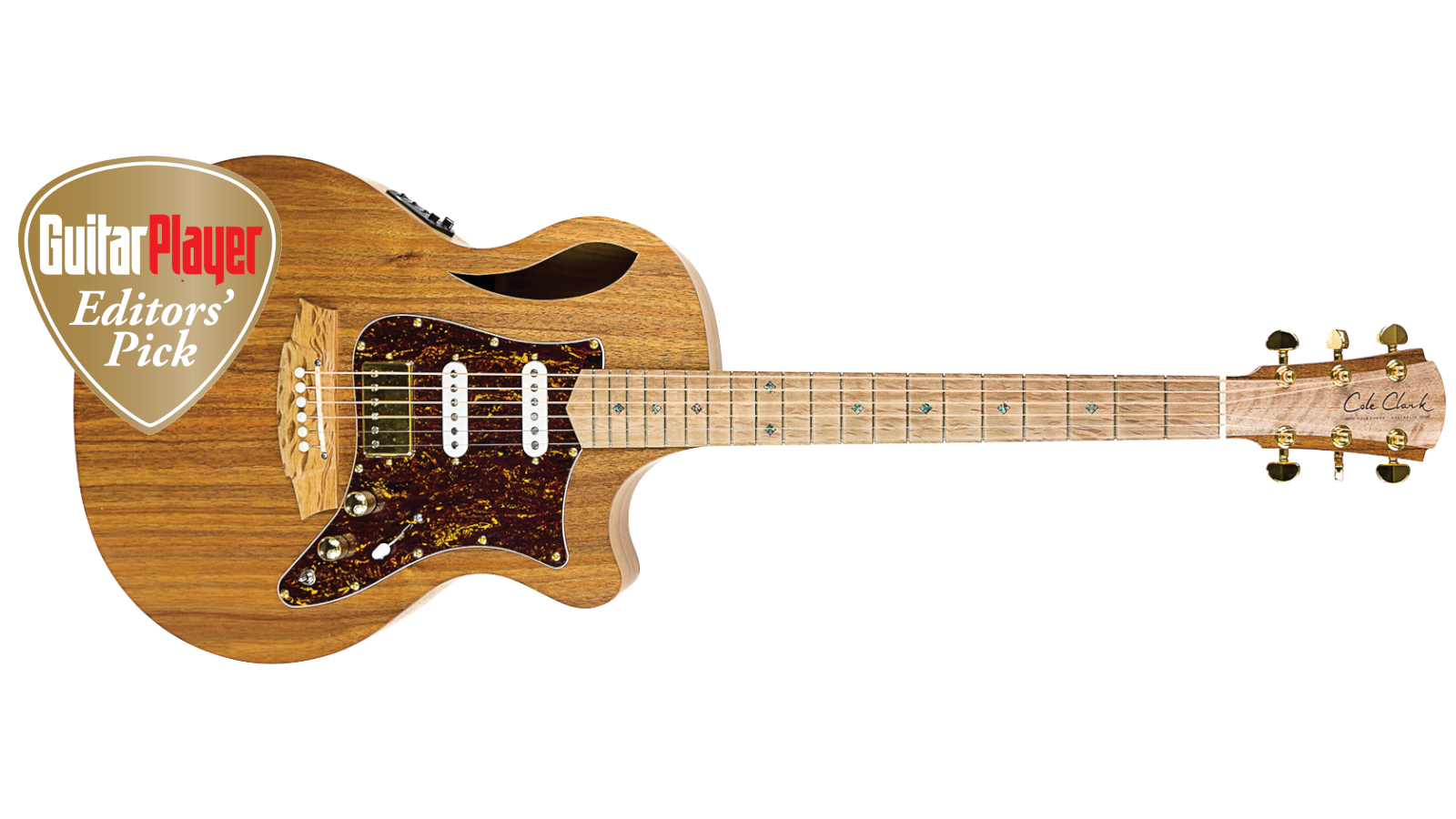GuitarPlayer Verdict
A blissful balance of acoustic and electric mojo with outstanding tone and playability
Pros
- +
Ingenious hybrid design delivers awesome amplified acoustic and electric tonal array from several pickup options and dual outputs
- +
Fine playability and craftsmanship
- +
Eco-conscious woods
Cons
- -
Mainly that skeptics may write this off as odd or obscure
You can trust Guitar Player.
Holy hybrid! What an intriguing acoustic/electric premise, promising the best of both worlds. Straight outta Melbourne, Australia, Cole Clark has been in business since the millennium flip and is probably most associated with Hawaiian superstar Jack Johnson’s acoustics.
They ceased making electrics in 2012, and have recently focused on manifesting the perfect fusion by blending advanced electronics with easy playability.
Noticing the trend of players adding magnetic pickups to their acoustics, Cole Clark launched a range of dual-output thinlines with built-in humbuckers in 2019. Their popularity led the company to dig deeper into the hybrid concept, ultimately releasing three models that truly straddle the acoustic/electric fence.
The True Hybrid range features Cole Clark’s three-way PG3 acoustic system augmented by their three-way electric system consisting of either three single-coils, a pair of humbuckers or the HSS configuration on this review model, the True Hybrid TL2EC-BLBL-HSS.
Being a bit of a crossbreed connoisseur, I was intrigued when the guitar caught my attention at the NAMM show and eager to take it for a test drive. This True Hybrid’s aesthetic embodies its crossover concept.
Sustainably sourced Australian Blackwood with a natural nitro satin finish provides an earthy backdrop for white single-coil pickups with white control knobs and a bowling ball-style pickguard that look like they could have been plucked from a vintage surf guitar.
The teardrop-shaped sound hole on the top upper bout adds a cool splash, as does the golden humbucker that matches the golden control knobs and the tuners on Cole Clark’s classic headstock crest. Teal abalone dot inlays adorn a she-oak fretboard. Somehow it all comes together harmoniously.
All the latest guitar news, interviews, lessons, reviews, deals and more, direct to your inbox!
The only element my eye finds slightly askew is the hard corner of a rectangular bridge bumping up against the curvaceous pickguard. A bit of rounding off would make it flow together better, but for being a bit of a unicorn, the True Hybrid looks pretty swift.
The unamplified tone from this thinline with thin strings and essentially a single f-hole isn’t going to win any campfire competitions compared to a pure acoustic, but it has a solid, well-balanced sound that’s far fuller than any hollow, semi-hollow or chambered body coming from an electric base. Sustain is particularly noteworthy. One of Cole Clark’s hallmarks is a Spanish heel, an integral neck-through design where one piece of wood goes all the way to the sound hole, as on a classical guitar. The neck is glued to a carved top and back, along with the sides, joined internally with a ridged system rather than a notched lining (i.e. kerfling).

It’s all designed for maximum vibrational conductivity, which relates to the pickups. Speaking of which, the patented PG3 acoustic system, introduced in 2022, is a combination of six individual undersaddle bridge piezos plus a top (face) sensor and a mic. The idea is that the bridge pickups gather most of the low end, the top sensor grabs the middle body information and the microphone captures the high end. The result is flexible, powerful and realistic.
The controls facilitate blending any balance you’d like, and Cole Clark has the crossover points dialed in wonderfully. The body sensor is incredible at capturing percussives. The most surprising aspect is how much body and mic ambience one can achieve without getting feedback. The PG3 system gave this thinline a grand sound through a little AER Tommy Emmanuel signature amp. How important is the PG3 in the manufacturer’s view? Cole Clark states, “We designed a pickup and built a guitar around it.”
They’ve done tons of research on the electric system as well, and it sure sounds like it paid off. Cole Clark has found a way to balance its patent-pending magnetic pickups in a way that delivers a full steel-string tone from a typical acoustic phosphor-bronze set.
According to the Aussies, most electric-style magnetics only capture the nickel core on the wound strings, but they’ve turned up the magnetism on the wound strings and down on the plain strings. The crazy thing is how much these magnetics also deliver a killer electric guitar sound from an acoustic set.
Plug the magnetic output into a classic tube amp, such as the ’66 Fender Pro used for these tests, and they sound like a hollowbody version of a Strat, Tele or Les Paul, depending on the pickup selection.
The single-coils sing, and the humbucker in the bridge is just right – neither too dull nor too bright. Put the two systems together and enter a vast wealth of uncharted tonal territory. What bliss to enjoy endless combinations of a percussive, robust acoustic tone along with a slinky, snappy electric tone.
Use pedals to add gain and effects to either or both outputs, and the possibilities are practically boundless. I blissed out on everything from jazzy warm and clean tones to raging blues-rock sounds facilitated by a devilishly delicious mix of thick overdrive from a Wampler Pexi Drive Deluxe coupled with harmonically rich grand-auditorium tones soaked in lush reverb.
I had a ton of fun using the new Fishman AFX Broken Record to loop an acoustic bed on the AER while ripping away over the top through the Fender.


The neck has the voluptuous feel and flatter radius of an acoustic, and since it’s designed to accommodate phosphor-bronze strings including a wound third, it certainly has an acoustic feel under the fingers. But the strings are extra light (gauges .011–.052), and the action is so easy that the True Hybrid practically plays like an electric.
I actually found the factory action to be a slightly too low to deal with aggressive fingerstyle or plectrum playing without some fret splat. A lighter touch was rewarded with nicely nuanced dynamics, and the action is easily adjustable via the truss rod.
A full 25.5-inch scale length yields a snappy string response, and in turn, bending requires a bit of gumption, especially in the upper register. Like a classic Strat, there are 21 frets. To me, that translated to 15th position being the uppermost where I felt full accessibility to all the licks I would normally play in the key of G. You can get to the key of A in the 17th position, but even with the cutaway it’s a tight fit as the neck joins the body in typical acoustic fashion at the 14th fret.
So the kind of leads one might wail up in the short rows on, say, an SG or a Les Paul isn’t readily available, but it’s darn close to that classic Strat situation, and I found the overall slinkiness very Strat-like as well.
I’d be thrilled to have the Cole Clark True Hybrid TL2EC-BLBL-HSS as my sole traveling companion
Riffs from the Hendrix/Vaughan canon flow easily from the fingers, and it’s wild to be able to wield them with the tonal flexibility of this True Hybrid.
As a bona fide Libra performer who often brings an array of acoustics and electrics to a gig, I’d be thrilled to have the Cole Clark True Hybrid TL2EC-BLBL-HSS as my sole traveling companion on a flyaway.
I tend to lean towards the acoustic side, and this instrument seems more of an acoustic with electric features than the other way around. That’s fine. Solidbodies or semis with piezos in the bridge tend to sound like an electric with a little lagniappe, even through dual rigs. Acoustics with magnetic pickups tend to yield something similar from the opposite angle. The True Hybrid delivers a blissful balance of acoustic and electric mojo.
Kudos to Cole Clark for manifesting its double vision with clarity on both sides of the paradigm, with respect to tone and playability. It’s a singular experience via dual outputs into dual amps, and the flexibility is awesome. For its execution of pure analog ingenuity, the Cole Clark True Hybrid TL2EC-BLBL-HSS earns an enthusiastic Editors’ Pick award.
Specifications
- NUT WIDTH: 1.73”, Tusq
- NECK: Queensland maple
- FRETBOARD: She-oak, 25.5” scale, abalone dot inlays
- FRETS: 21
- TUNERS: Grover, gold
- BODY: Thinline grand auditorium with solid Australian Blackwood back, sides and top
- BRIDGE: She-oak with Tusq saddle
- ELECTRONICS: Dual 3-way pickup systems feed dual outputs: Cole Clark PG3 acoustic is six individual undersaddle piezos plus a body sensor and a microphone. Onboard preamp with master volume knob and treble, middle and bass sliders. Bridge/Face and Mic blend knobs plus FC (Filter Contour) button. Cole Clark electric system is three balanced magnetic pickups in HSS configuration (bridge humbucker, middle and neck single-coils) with 5-way selector switch, volume and tone with push/pull pot on tone control for series or parallel on humbucker. Global 3-way mini-switch toggles between acoustic, electric or both systems
- FACTORY STRINGS: Phosphor bronze extra light .011–.052 as tested. Will ship with .010 to .047 in future
- WEIGHT: 6 lbs (as tested)
- BUILT: Australia
Visit Cole Clark for more information.
Jimmy Leslie is the former editor of Gig magazine and has more than 20 years of experience writing stories and coordinating GP Presents events for Guitar Player including the past decade acting as Frets acoustic editor. He’s worked with myriad guitar greats spanning generations and styles including Carlos Santana, Jack White, Samantha Fish, Leo Kottke, Tommy Emmanuel, Kaki King and Julian Lage. Jimmy has a side hustle serving as soundtrack sensei at the cruising lifestyle publication Latitudes and Attitudes. See Leslie’s many Guitar Player- and Frets-related videos on his YouTube channel, dig his Allman Brothers tribute at allmondbrothers.com, and check out his acoustic/electric modern classic rock artistry at at spirithustler.com. Visit the hub of his many adventures at jimmyleslie.com

